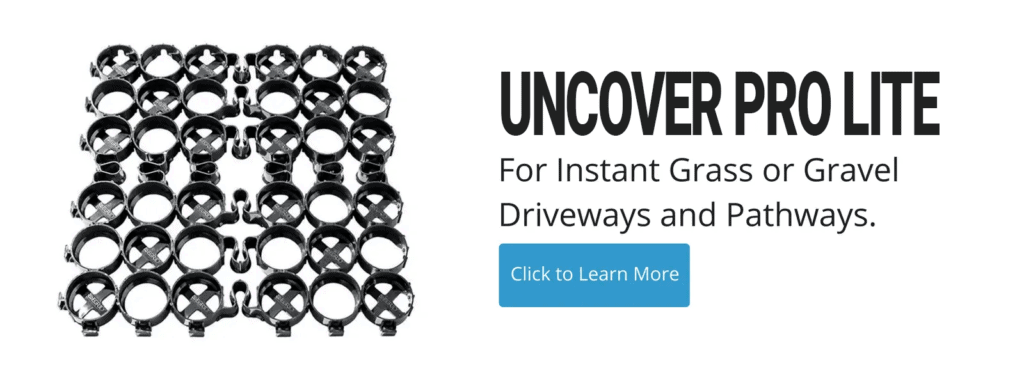How to Take Advantage of Houston’s New Green Stormwater Incentive Program
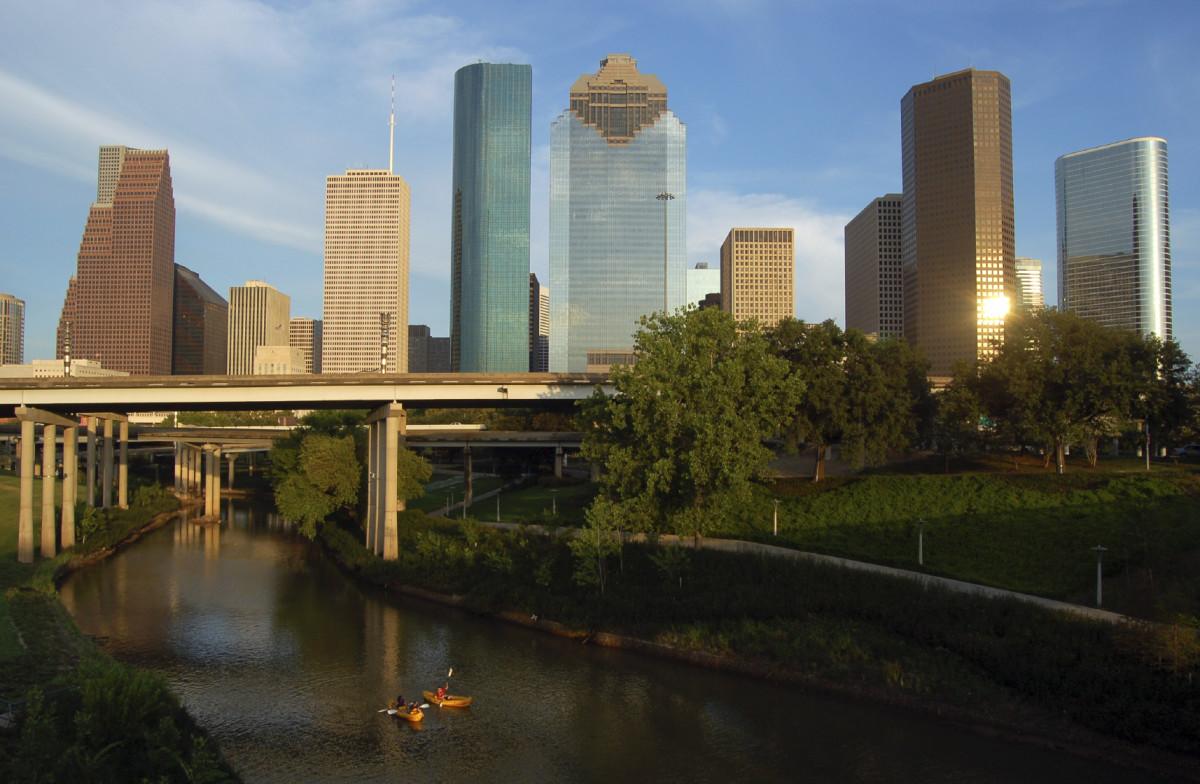
Flooding has become a major problem in many coastal areas of the United States, particularly in the Southern states. Houston is one example of a major city that has seen unimaginable destruction and devastation in their city as a result of flooding.
Being situated just barely above sea level, Houston is forced to take the brunt of many hurricanes and gulf storms, some of which overload the city’s stormwater management systems and cause widespread flooding. Thankfully, there are plenty of ways to address the flooding problem that Houston faces. One of these is the new Green Stormwater Incentive program, otherwise known as the GSI.
The GSI is a program set up to incentivize the use of green stormwater management infrastructure during new developments. By embracing the program and its incentives, developers can reap incredible tax benefits while gradually turning Houston into much less of a disaster area when big floods hit.
In case you’re wondering how this works, let’s take an in-depth look at just how the GSI program works and how you can get the most out of it while fortifying your property from flood damage in the process.
Breaking Down the GSI Program in Houston
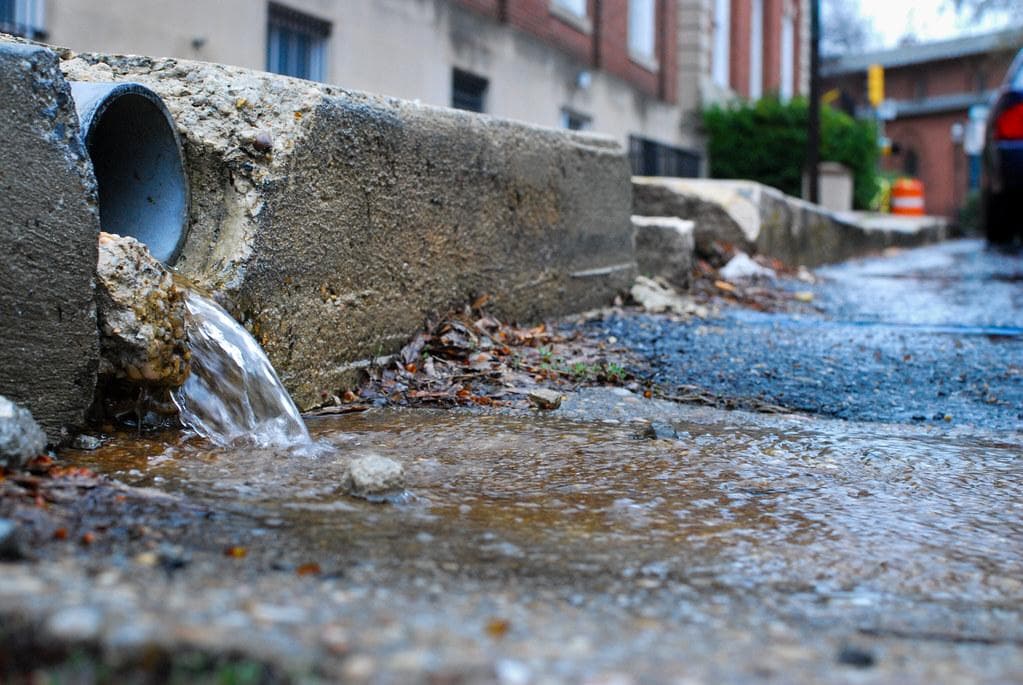
The GSI program is designed to increase usage and implementation of green stormwater infrastructure that promotes more effective stormwater management. This includes products and materials that will minimize the downstream effects of development, while also providing benefits or services to the local ecosystem, society, and/or environment.
Materials and infrastructure that help to reduce the heat island effect, mitigate the risk of flooding, encourage water conservation, create economic growth, restore native ecosystems, or address changes in quality of life are all incentivized under this program.
In order to qualify for a tax abatement under the GSI program, a new development has to meet a number of requirements. These requirements are in place to help keep the incentives location-specific to problem areas in and around Houston, and are mostly aimed at huge development projects.
For example, a new development must start out with at least a $3,000,000 investment and have at least $200,000 dedicated to new green stormwater infrastructure. If these criteria are met, a developer could have up to 100% of their investment in green stormwater infrastructure abated over 10 years.
There are multiple criteria to determine how much of a tax abatement will be given, such as the total proportion of project dollars dedicated to green stormwater infrastructure and the environmental impact of the design. This program is designed to incentivize investment in the highest standard of green stormwater infrastructure.
For instance, the above-mentioned 100% abatement over ten years would only apply to a development that invested in the highest standard of infrastructure and implemented an effective design as well. The city hopes that by implementing such a drastic tax abatement program for new green stormwater infrastructure, they’ll eventually be able to fortify the urban areas of Houston and make the city much more resilient when it comes to flooding.
With enough interested parties aiming to meet the requirements of the GSI program, Houston hopes to minimize its flooding issues while generally raising the property value of new developments over the long-term.
Read More: NEW 2021 CITY OF HOUSTON STORMWATER DETENTION REQUIREMENTS EXPLAINED
How to Make the Most of Houston’s New GSI Program

The potential for tax abatement under the GSI program hinges on the quality and environmental impact of your proposed green infrastructure. Assuming you meet the investment threshold and ratio of green infrastructure spending, there are many different options for implementing eco-friendly stormwater management. Some of these include conservation ponds as well as permeable pavement.
Permeable pavement is one of the most effective ways to help qualify a project for the GSI program. The permeable plastic pavers made by TRUEGRID, for instance, are incredibly effective at managing stormwater and reducing the strain on local sewer systems. They are able to drain water into the soil at an incredible rate. TRUEGRID pavers are made from 100%-recycled plastic and require almost no maintenance once installed.
They work by draining stormwater into a sub-base filled with gravel, where it is naturally filtered back into the water table at a healthy rate. This is essential for mitigating the effects of flooding like the kind commonly seen in Houston. These pavers can be used to build grass parking lanes and walkways, as well as industrial-strength parking lots meant to handle the heaviest vehicles.
The reduced burden on local storm systems and efficient diversion of stormwater away from vulnerable areas makes permeable pavement like TRUEGRID one of the smartest materials to include in any development looking to qualify for the new GSI program in Houston.
Save Money and Help Houston Prevent Flooding with the Green Stormwater Incentive Program
Flooding is one of Houston’s biggest problems right now, but you can help minimize the damage by qualifying your next development project for the new GSI program. By designing a project to meet the qualifications laid out in the new GSI, you can receive up to a 100% return on your investment while also helping Houston prevent the myriad of issues that recurring flooding has presented them with.
If you’re interested in implementing permeable pavement into your next development, contact TRUEGRID today for a quote.
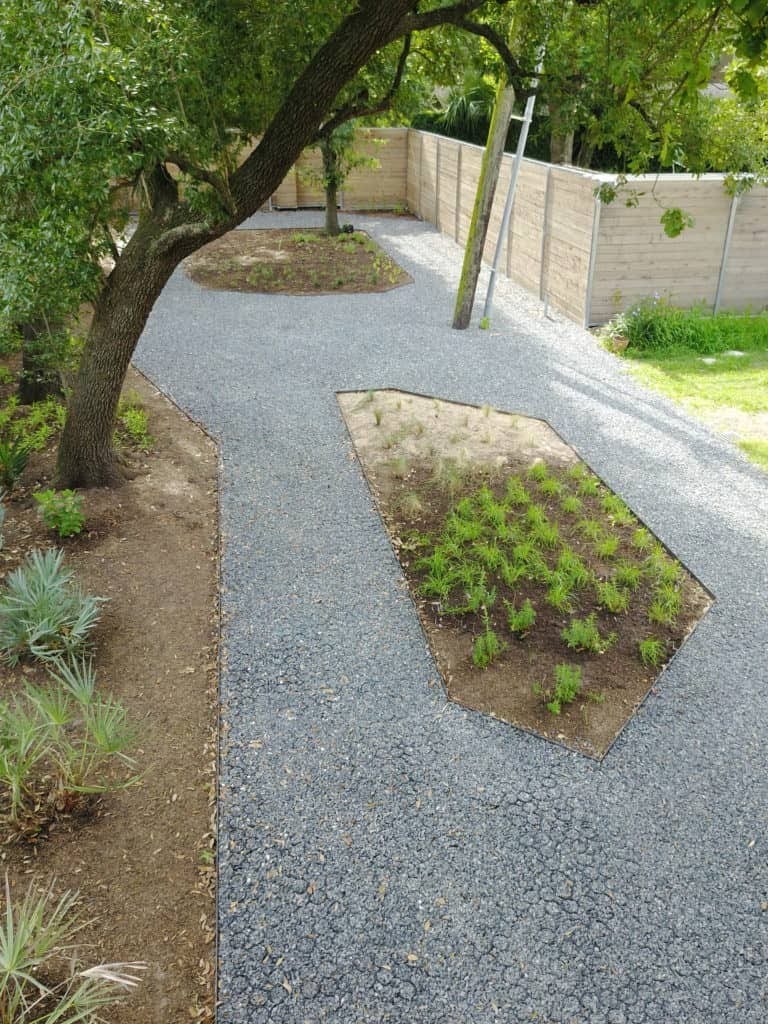
Gravel driveways and walkways have their own distinct appeal, and one of the most popular types among homeowners is pea gravel. Pea gravel is usually made up of small rocks and stones about the size of green peas, hence the name.
Pea gravel is small enough to form a solid, level surface for walking and driving, especially when used in conjunction with a stabilizer grid. The space between pieces of gravel is enough room for water and other liquids to drain through as well, making it permeable to a degree.
There’s plenty to learn about how to pack pea gravel during the installation process, as well as how to seal a pea gravel walkway, so in case you want to learn about installing a pea gravel driveway or walkway, let’s go over everything you need to know.
Preventing the Spread of Pea Gravel
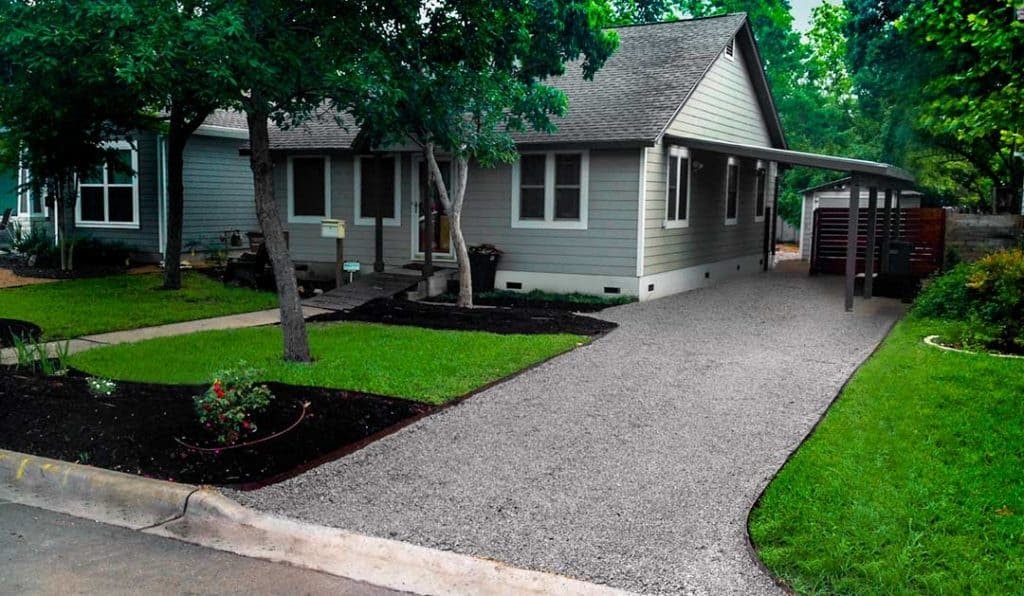
The main thing you need to know about a pea gravel driveway or walkway is how to keep the gravel in place. Pea gravel is made up of many small pieces, so it cannot be used as loose material for driveways or walkways, as it simply spreads too easily.
Thankfully, there are a number of options for how to keep pea gravel from washing away. The two most effective methods for stabilizing pea gravel are cement and permeable pavers. If you’re stabilizing pea gravel with cement, it will hold for a while until it’s eventually damaged by traffic and water exposure.
A pea gravel binding solution like cement will not be permeable and will displace water to the edges of the pavement. This can lead to erosion and even flooding, in severe cases, and if you don’t know how to seal a pea gravel driveway, you’ll have to pay someone to do it every few years or so to prevent water infiltration.
Another way to stabilize a pea gravel walkway or driveway, however, is with permeable pavers. Pavers by TRUEGRID, for instance, will hold the pea gravel in place without the use of binding agents. They are made up of empty cells which are filled with gravel and held in place by the weight of it. Installation will be quick and easy.
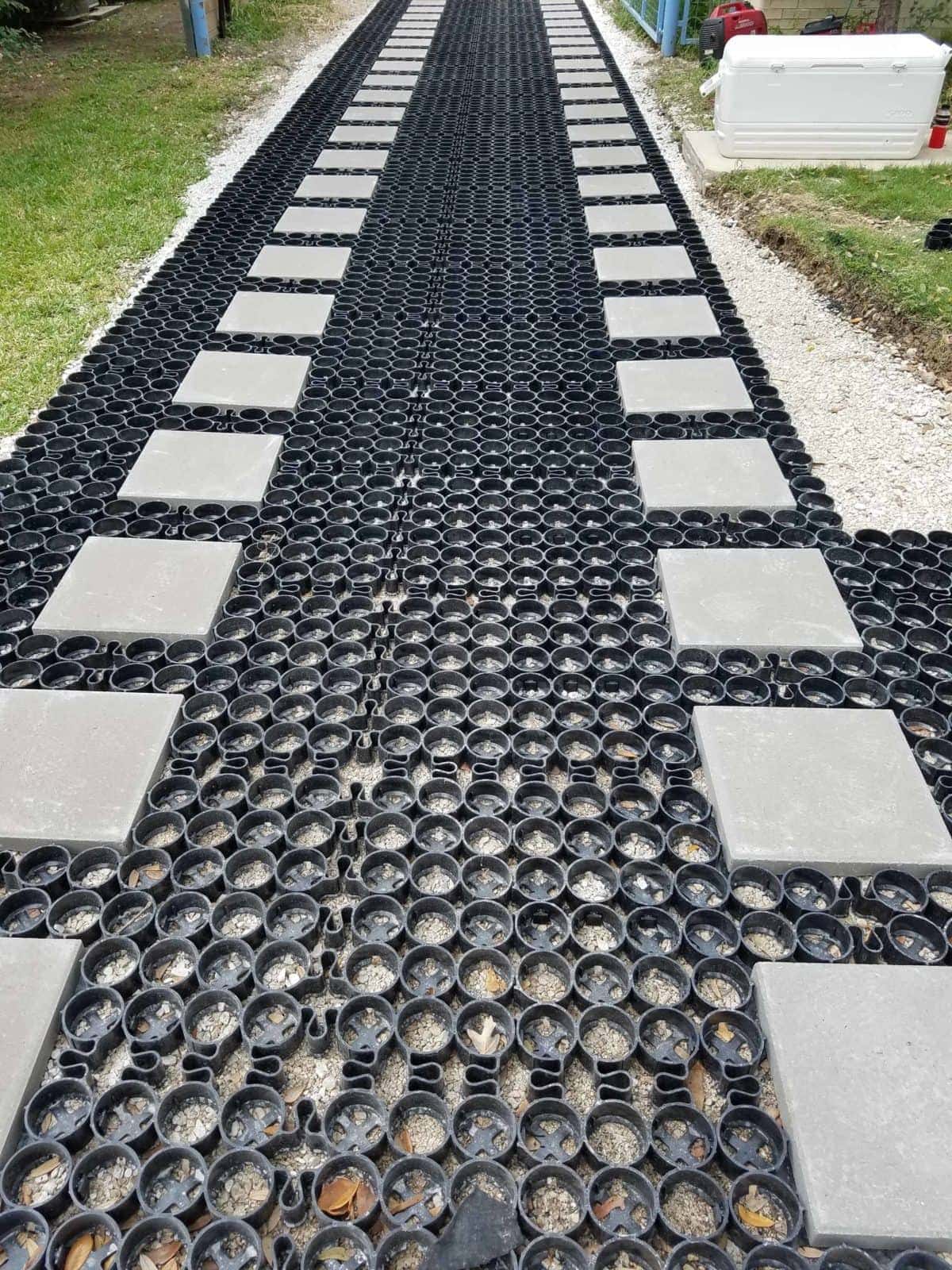
The process for how to set pea gravel into TRUEGRID pavers is simple. First, the desired paved area is excavated to a depth of about 1 inch. Next, it’s filled to the top with pea gravel and compacted. Then, the empty pavers are snapped into place over the top of the filled pit.
Afterward, the surface pavers are filled with gravel and the pea gravel is set into place by driving over it with a vehicle or heavy roller. This is the entire installation process in a nutshell, completed much faster than if you were to use concrete, and it doesn’t require any special equipment..
Using Permeable Pavers for a Higher-Quality Pea Gravel Driveway
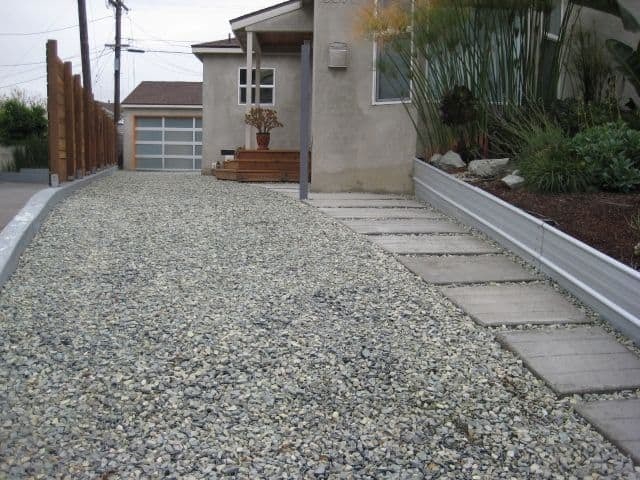
The main benefit of using permeable pavers for pea gravel walkways and driveways is their durability. TRUEGRID permeable pavers will last up to 60 years with almost no maintenance required. Compared to a cement pea gravel driveway or pathway, this will cost you thousands of dollars less over the course of its lifetime.
TRUEGRID plastic permeable pavers are also better for the environment because they’re made from 100%-recycled plastic and take far fewer resources to produce and install. They also help to accentuate the aesthetic beauty of pea gravel better than a grey or off-white cement. The cell walls are only semi-visible from the surface, allowing the pea gravel to stand out more.
With TRUEGRID permeable pavers, you will never have to worry about how to firm up pea gravel, or how to use binding agents to prevent it from spreading. You can use your pea gravel as-is, allowing the pavers to do all the work of keeping it tight and compact.
Whether you’re building a driveway for heavy usage or a basic footpath, TRUEGRID pavers provide a vastly superior level of stylistic flexibility, durability, cost-effectiveness, and eco-friendliness.
Let TRUEGRID Help You Create the Perfect Pea Gravel Driveway or Pathway
Cement is a crude and flawed solution for stabilizing pea gravel. If you really want to get the most out of this unique and versatile material, you need to stabilize it with TRUEGRID permeable pavers. Not only will you save time and money on long-term maintenance, your pavement will look cleaner and will avoid erosion and flooding problems, last longer, and provide a much more eco-friendly solution than cement.
If you’re designing a pea gravel pathway or walkway, contact a pavement professional at TRUEGRID today to help you get started.
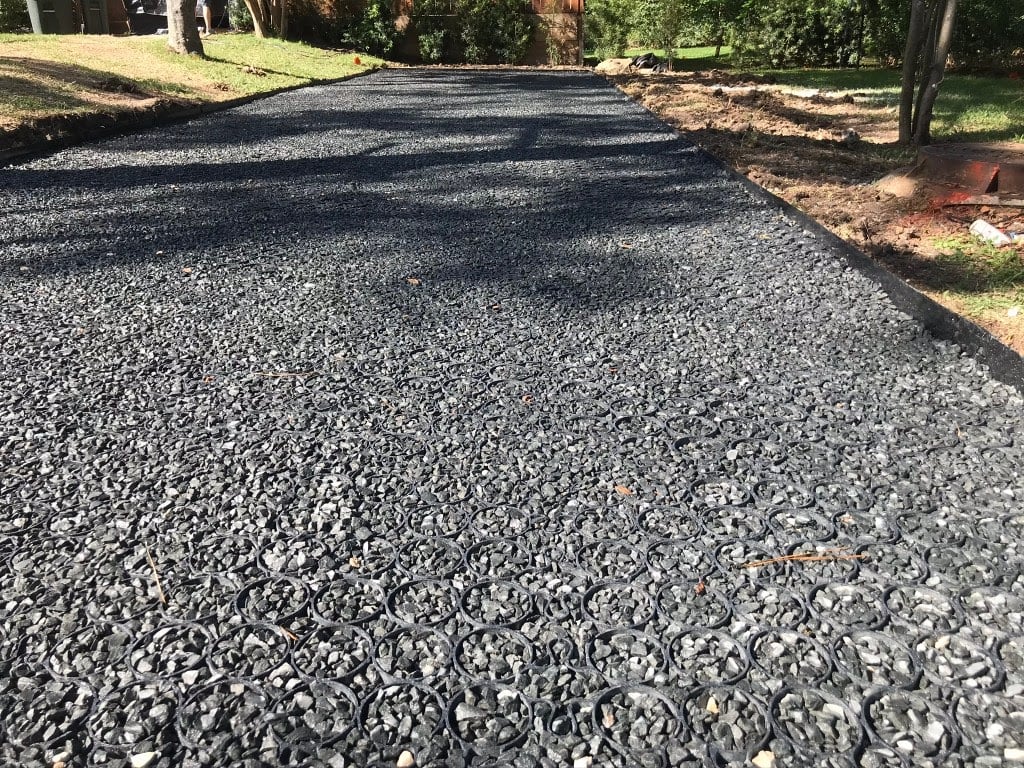
A properly installed and maintained TRUEGRID gravel driveway is durable enough to handle all types of vehicle traffic and will last up to 60 years without cracking or breaking down in the sun, rain, or other types of weather like asphalt does.. Choosing the best gravel for driveway usage is only part of the equation.
If you want to build your gravel driveway the maintenance-free way, get in touch with the pavement professionals at TRUEGRID today for a quote.
PRO LITE

If you’re a business owner or in charge of developing the budget for a piece of property with a parking lot, you know that parking lot maintenance is often a sizable chunk of the expense.
Most parking lots are made from materials like asphalt and concrete, so they are constantly in a state of erosion and will inevitably need to be serviced a variety of ways, multiple times throughout their lifetime. The installation of these lots is no small cost, but the parking lot repair cost can add up to quite a hefty amount as well, depending on the size.
In case you aren’t aware of what it takes to maintain the average parking lot, let’s break down the costs of repairing concrete and asphalt parking lots, as well as a superior parking solution.
Common Damage Found in Asphalt and Concrete Lots
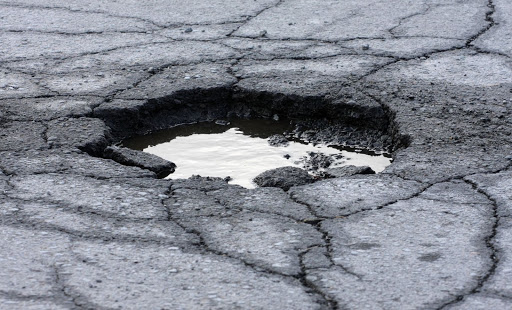
Concrete and asphalt are the most common parking lot materials because they were the first viable parking solutions that were able to withstand heavy traffic over prolonged periods of time. However, they aren’t without their own issues. Concrete and asphalt are both extremely susceptible to water damage.
Once the surface of a parking lot has been damaged or worn down even slightly, water is able to infiltrate and wreak havoc. Especially in areas with free-thaw cycles, water freezes and expands in the cracks, gradually widening them. Eventually, this can lead to giant crevices and potholes, which lead to huge parking lot maintenance costs, and possibly incurred damages.
The Cost of Maintaining Asphalt and Concrete
Parking lots need to be maintained in order to stay safe and aesthetically pleasing to customers. The most basic maintenance is sweeping. The cost to sweep a parking lot is low, but sweeping needs to be done frequently. For a lot with 1,000 parking spaces, the cost to sweep and clean is about $163, on average.
The average cost to sweep and clean a lot with 500 parking spaces is about $83. For a 200-space lot, it’s about $79, and a 25-space parking lot costs an average of $77. The parking lot sweeping cost per square foot is low, so you’ll often only find price quotes on a per-space basis, but depending on how often your lot needs to be swept and cleaned, this can add up to a big annual cost.
Sweeping and cleaning are only the start of it though, once your asphalt has become unraveled and/or developed cracks and potholes, it will need to be resurfaced. If you’re wondering how it costs to resurface a parking lot made from asphalt, you can expect to pay anywhere from $1.50 to $7 per square foot.
The cost to reseal an asphalt parking lot is anywhere from $0.14 to $0.25 per square foot. New sealcoats will need to be applied about every 2-4 years, and the asphalt lot will have to be resurfaced about every 20 to 25 years.
For concrete, the costs are similar. A concrete parking lot needs to be resealed every 3 years and resurfaced every 15 to 25 years. The concrete parking lot sealing cost is expensive, ranging from 10 to 30 cents per square foot. The cost to repave a parking lot made from concrete is anywhere from $3 to $10 per square foot.
Once you factor in the cost to reseal a parking lot made from either asphalt or concrete, as well as the cost of repaving a parking lot made from either of these materials, it adds up to the brunt of the maintenance expenses.
In addition, lot lines also need to be repainted, and the cost can vary depending on the number of lines. For smaller lots with 50 spaces or less, expect to pay about $500.

If you don’t already have lines, the total cost to paint parking lot lines could increase by 20% to 50%. For a parking lot with over 50 spaces, $700 minimum is the expected rate from most companies.
A TRUEGRID Parking Lot is Nearly Maintenance-Free

If you want to nearly eliminate the asphalt parking lot resurfacing cost as well as all the other costs associated with maintaining asphalt and concrete, look no further than TRUEGRID permeable pavers. TRUEGRID PRO PLUS pavers are designed for high-traffic, commercial areas and allow water to drain right through. They will last up to 60 years without breaking down.
They are durable enough to handle all types of traffic at any level of frequency and never need to be repainted, resealed, or resurfaced. They’re also very stylistically diverse and professional-looking, which makes them great for any parking lot, anywhere.
If you want a superior parking lot solution that won’t cost you tens of thousands of dollars in maintenance, get in touch with a pavement professional at TRUEGRID today.
Having a sloped driveway can be a big challenge, especially if you want yours to be made of gravel. A gravel driveway on a slope presents a number of challenges to homeowners.
Gravel is known for certain characteristics when used in a driveway and having gravel on a slope can exacerbate these issues. However, if you’re asking, “Can you lay gravel on a slope?”, the answer is yes. You simply need to use the right materials and installation method for mitigating the common issues seen with gravel.

In case you want to know how to stop gravel from moving on a slope, let’s go through a breakdown of making a driveway on a hill out of gravel and how to retain gravel on a slope.
Gravel as a Driveway Material
Gravel is used by homeowners for driveways of all shapes and sizes. Unlike asphalt and concrete, it’s much cheaper and stylistically versatile. There are many different types and colors of gravel, so it fits in well with a larger variety of color and aesthetic themes. However, the defining characteristic of gravel is that it’s loose.
Gravel is a combination of many small stones and rocks. For this reason, the number one issue with a gravel driveway on a steep slope is that gravity tends to act on loose gravel, pulling it loose and sending it tumbling down your sloped driveway. The spreading of gravel is a problem with any unstabilized gravel driveway, but especially bad on a steep hill.
How to Build the Perfect Driveway on a Slope with Gravel
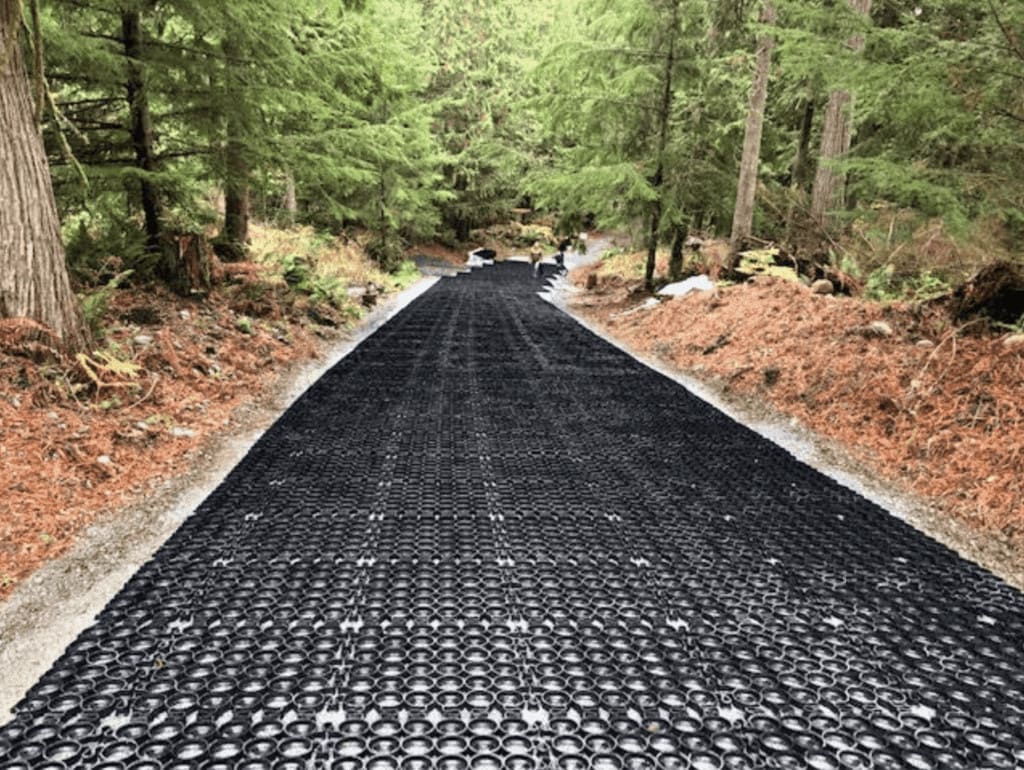
The only option for keeping gravel in place on a slope is to stabilize it with pavers. Pavers are locked into the ground and they trap gravel in place, preventing it from coming loose and spreading, even under heavy vehicle traffic. The number one choice of pavers for a gravel driveway is either TRUEGRID PRO pavers or TRUEGRID PRO PLUS pavers, depending on the type of traffic they’ll be seeing.
Both of these paver types can accommodate gravel for a steep driveway, locking it down and providing a durable surface with excellent traction for vehicle tires. If you are wondering how to stabilize a steep gravel driveway the right way, TRUEGRID pavers are the answer.
TRUEGRID pavers are made from 100%-recycled plastic and are durable enough to last up to 50 years with almost no maintenance. The only method for containing gravel on a slope is TRUEGRID pavers. Without a stabilized gravel slope, your driveway is sure to experience massive erosion and spreading. TRUEGRID pavers trap the gravel within the empty cells of the interlocking pavers, weighing it down and preventing the gravel and the pavers from moving.
TRUEGRID pavers are the most effective method keeping gravel in place on a slope, but you might be wondering how to build a driveway on a hill in an eco-friendly manner. TRUEGRID pavers are nearly 100%-permeable and one of the most eco-friendly paving options on the market.
Worrying about erosion is a thing of the past with these pavers, and you’ll never have to wonder about how to grade a driveway on a hill again. Since TRUEGRID’s pavers are almost entirely permeable, they allow water to pass right through them. This is especially useful when dealing with the maximum slope for a gravel driveway because the water doesn’t have a chance to run down and pull gravel along with it.
The installation process is also quick and easy, and is also one of the best options for building a gravel driveway on a hill. First, the desired paving area is excavated to a depth of about 12 inches and a piece of fabric is laid at the bottom to prevent gravel migration. Then, gravel is poured in to fill the pit and then it is easily compacted with a heavy roller or ordinary vehicle..
Next, the TRUEGRID pavers are easily snapped together like LEGO® blocks and laid over the top, with more gravel being poured over them and pressed into their surface. Once this is complete, vehicles can begin driving over the driveway to compact the pavers.
The Only Way to Effectively Build a Sloped Driveway with Gravel is By Using Permeable Pavers
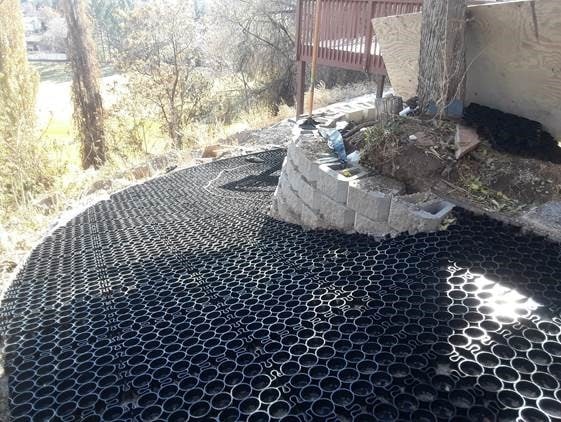
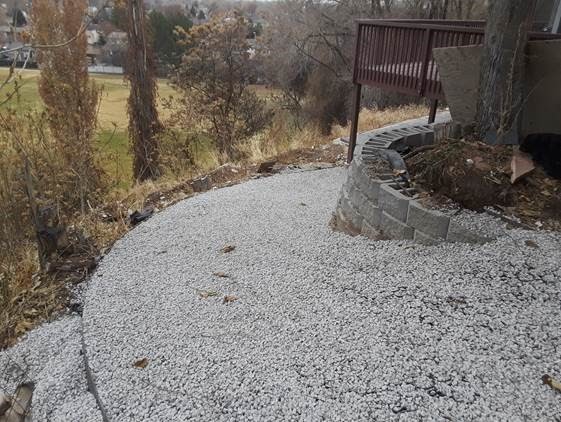
The durability, permeability, and effectiveness of TRUEGRID PRO and TRUEGRID PRO PLUS permeable pavers makes them the best solution for how to make a gravel driveway on a hill, without question.
The PRO PLUS pavers are also durable enough to make them a superior option for how to build a gravel road on a hill as well.
Once you tally up all the great features and characteristics, it’s clear that TRUEGRID pavers are the best choice for how to contain gravel on a slope. If you want the world’s most effective, stylish, and eco-friendly method for stabilizing gravel on a slope, request a TRUEGRID quote today.
Option for the base layer of a gravel driveway is item #4. Item #4 is comprised of sand, dirt, and golf ball-sized stones. This type of gravel is available in a few different variations including recycled item # 4, which is made up of recycled stones, brick, blacktop, concrete, and rock.
There is also quarry item #4, or crushed limestone, gray item #4 which appears dark grey in color, and crushed bluestone item #4. Crushed bluestone item #4 is usually found in municipal driveways, though.
5 Types of The Best Surface Gravel for Driveaway
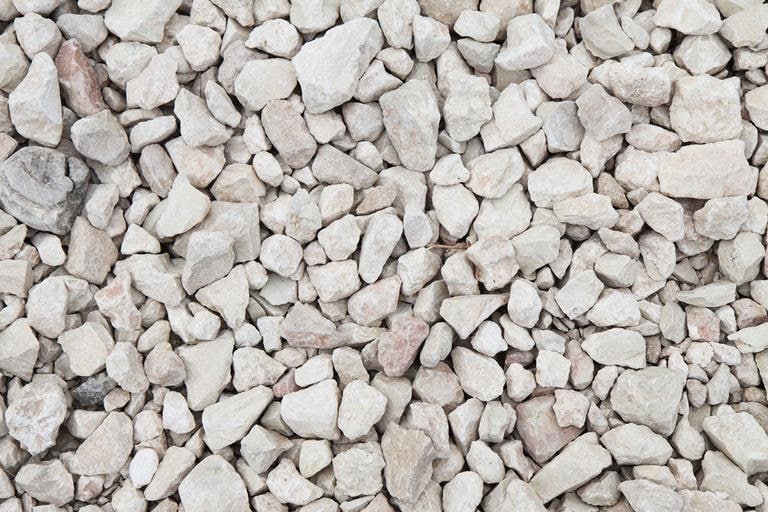
There isn’t a lot of variety for the bottom layers of a gravel driveway, however, there are more options when it comes to finding the best gravel for driveway surfaces. Among the other options are crushed stone #411, quarry process, pea gravel, jersey shore gravel, marble chips, and river rock. These are the best options for driveway surfaces gravel, because they are small stones combined with rock dust, which makes a more solid driving surface.
1. Crushed Stone #411
It is crushed up #57 stone combined with rock dust. This mixture is able to handle moderate traffic from heavy vehicles.
2. Quarry Process
It is also called “crusher run” and works well for the surface of both driveways and walkways. It’s made from stone dust fines and crushed stone.
The stone dust will settle and become compact to create a semisolid surface that is smooth. It is important that you know that this type of surface gravel needs to be sloped towards the sides of your driveway for better drainage.
3. Pea Gravel
Pea gravel is popular gravel for driveway aesthetics. It’s made up of round, small stones that can come in many different colors. This type of gravel will easily migrate and spread under the weight of vehicles, though, and needs to be stabilized for long-term, maintenance-free usage.
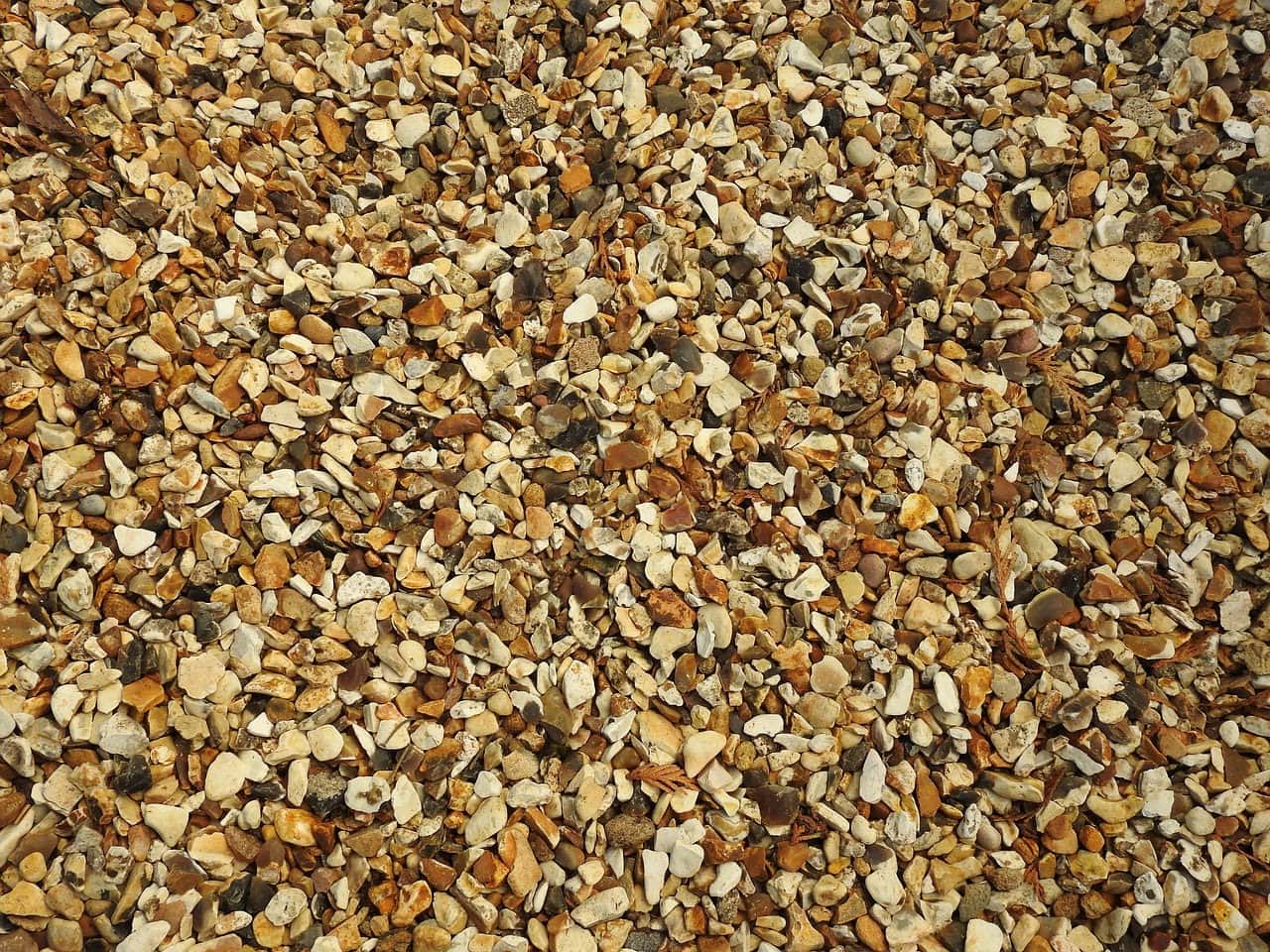
4. Jersey Shore Gravel
It is made of yellow, tan, white, gold, and brownstones and looks quite a bit like sand. It’s similar to pea gravel since it needs borders or stabilizing pavers to prevent it from spreading.
5. Marble Chips
Marble chips are white and they sparkle in the sunlight. They typically cost more than other gravel types but are another favorite when it comes to being the best gravel for driveway aesthetic appeal. This type of gravel also needs a border or stabilization to prevent it from spreading, migrating, and washing away.
6. Blackstar or Blacktrap Rock
A very attractive dark gray gravel, this is an excellent choice as it is angular and locks together. When combined with stabilizing grid paving system, this provides a super durable and beautiful driveway.
A Better Alternative to Typical Gravel Driveways
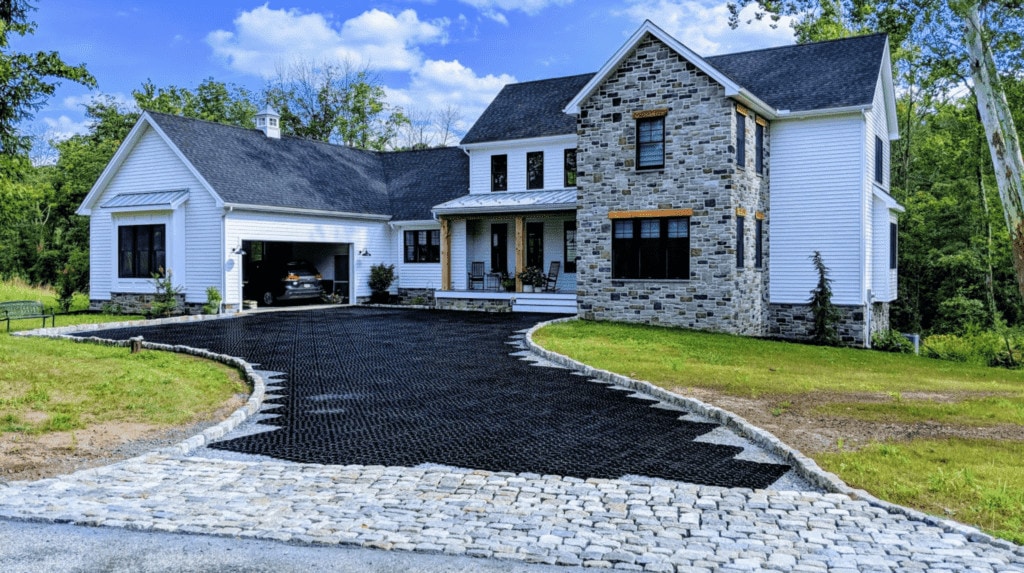
Some of the aforementioned gravel types require stabilization, but the best way to construct any gravel driveway is by using TRUEGRID permeable pavers to lock in your gravel.
TRUEGRID PRO LITE and PRO PLUS stabilizing pavers simply require fill gravel and surface gravel, although you can use the same type of gravel for both. The fill gravel is poured over the top of a piece of fabric at the bottom of the excavated area where you want your driveway that provides drainage for water and other liquids.
It is then compacted and leveled before TRUEGRID permeable pavers are snapped in place over the surface. Next, your surface gravel of choice is poured over the pavers and locked into place using a heavy roller or vehicle. This weighs the pavers down and locks them securely into place.
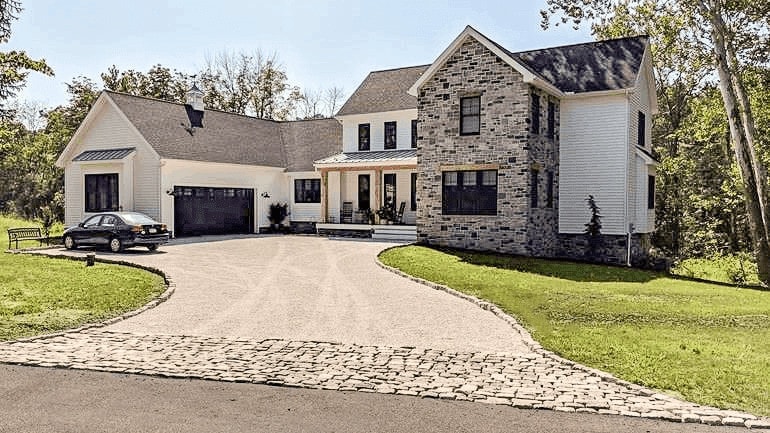
The main benefit of using TRUEGRID pavers to build a gravel driveway is that they will keep your gravel in place, eliminating the need for almost any maintenance during the course of your driveway’s lifetime.

A properly installed and maintained TRUEGRID gravel driveway is durable enough to handle all types of vehicle traffic and will last up to 60 years without cracking or breaking down in the sun, rain, or other types of weather like asphalt does.. Choosing the best gravel for driveway usage is only part of the equation.
If you want to build your gravel driveway the maintenance-free way, get in touch with the pavement professionals at TRUEGRID today for a quote.

